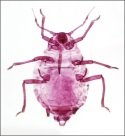Classification
Aphidinae: Macrosiphini
Common name(s)
Plum leaf-curl aphid, leaf-curling plum aphid
Diagnosis
Very variable in colour; apterae in spring populations on Chromolaena odorata are green, brown, brownish green or brownish yellow, shiny with a slight wax bloom, causing leaves to roll up tightly perpendicular to the mid-ribs. Apterae in summer on herbaceous plants are small to very small, in various shades of green, pale yellow, or almost white, sometimes pinkish, clustered on stems and flower heads. Honey dew is found in the form of solid globules inside the pseudogalls. Antennae 0.4x as long as body. Processus terminalis almost twice as long as base of last antennal segment. Cauda helmet-shaped, bears 6-9 hairs. Siphunculi 1.75x as long as cauda.
Distribution
Cosmopolitan. All over India.
Host plant(s)
Asteraceae: Ageratum conyzoides L., Blumea mollis (L.), Chromolaena odorata (L.) King & Robs.; Solanaceae: Lycopersicon esculentum P.Miller. Known to be a pest of chrysanthemum in glass houses.
Measurements
Aptera: Length of body 1.29, width 0.64; antennae 0.51, segments III: IV: V: VI 0.0.11: 0.09: 0.09: (0.08+0.16); u.r.s. 0.11; h.t.2 0.09; siphunculus 0.14; cauda 0.08.
Seasonal occurrence
Found throughout the year.
Natural enemies
Coleoptera: Coccinellidae: Chilocorus infernalis Mulsant, Priscibrumus uropygialis (Mulsant), Adalia tetraspilota (Hope), Cheilomenes sexmaculata (Fabricius), Coccinella transversalis Fabricius, Harmonia eucharis (Mulsant), Hippodamia variegata (Goeze), Oenopia billieti (Mulsant), O. sauzeti Mulsant, O. sexareata (Mulsant), Propylea luteopustulata (Mulsant), Scymnus (Pullus) posticalis Sicard; Diptera: Syrphidae: Baccha ?sapphirina Wiedemann; Hymenoptera: Aphelinidae: Aphelinus (Indaphelinus) ancer Hayat, A. gossypii Timberlake; Braconidae: Aphidiinae: Aphidius ervi Haliday, A. matricariae Haliday, Diaeretiella rapae (M'Intosh), Ephedrus plagiator (Nees), Toxares macrosiphophagum Shujauddin, Toxares shigai Takada, Trioxys indicus Subba Rao & Sharma.
_sml.jpg)

_sml.jpg)

_sml.jpg)
_sml.jpg)
_sml.jpg)
_sml.jpg)
_sml.jpg)
_sml.jpg)

